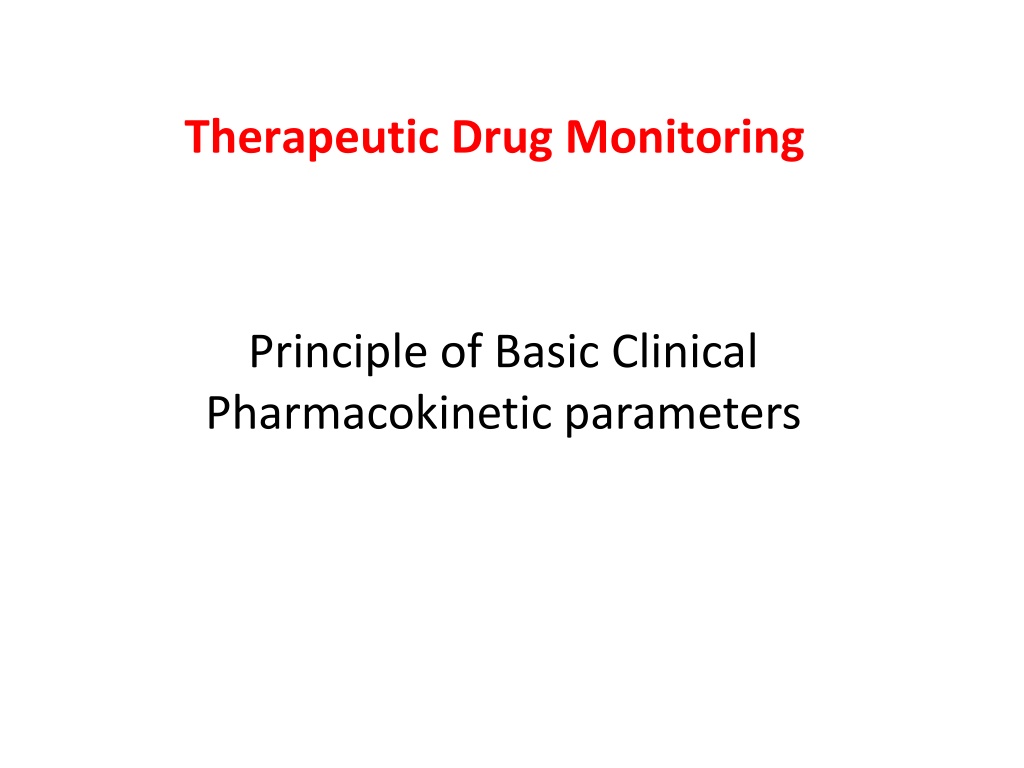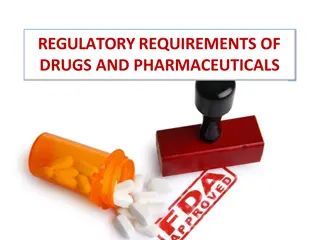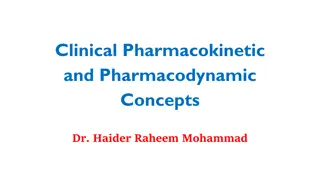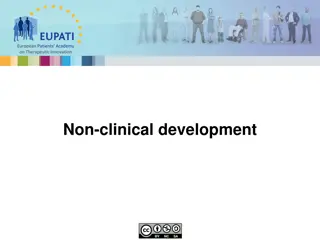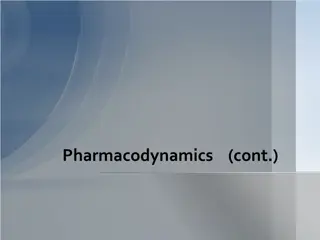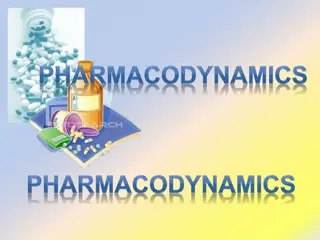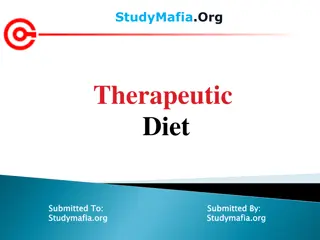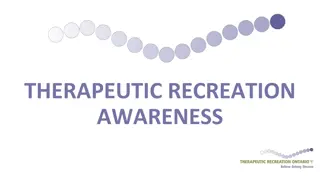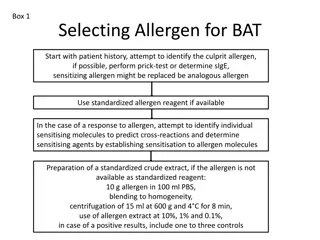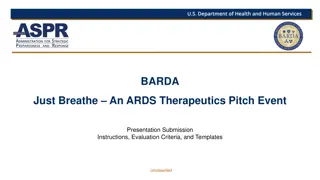Understanding Therapeutic Drug Monitoring and Clinical Pharmacokinetic Parameters
Therapeutic Drug Monitoring (TDM) utilizes pharmacokinetic principles to optimize drug therapy by balancing efficacy and toxicity levels. Historical background reveals a shift from empirical dosing to precise pharmacokinetic analysis, aiming to minimize toxicity risks and maximize therapeutic benefits. Key pharmacokinetic processes include absorption, distribution, and metabolism, crucial for effective drug delivery and action.
Download Presentation

Please find below an Image/Link to download the presentation.
The content on the website is provided AS IS for your information and personal use only. It may not be sold, licensed, or shared on other websites without obtaining consent from the author. Download presentation by click this link. If you encounter any issues during the download, it is possible that the publisher has removed the file from their server.
E N D
Presentation Transcript
Therapeutic Drug Monitoring Principle of Basic Clinical Pharmacokinetic parameters
Background and historical introduction Until the 1960s, trial and error was the most common scenario for drug management. Even though the guiding principles were usually obtainable and believable to be efficient and safe, majority of practitioners implement dosing in an empirical approach. Doses were frequently started at low ranges and increased gradually until an improvement is achieved or, in spite of the guidelines, toxic effects manifested.
Background and historical introduction With the realization that standard dosage regimens resulted in unreliable patient outcomes, researchers start to find analytical facilities that can more precisely describe the pharmacokinetic characteristics and therapeutic ranges. As a consequence, the last few decades showed an obvious growth in the concept of therapeutic drug monitoring (TDM), especially pharmacokinetics and pharmacodynamics research. in the area of
Background and historical introduction The main goal of applying clinical pharmacokinetic and pharmacodynamic principle relationship concept was: Optimizing drug therapy Therefore, increased efficacy without unacceptable toxicity or reduced toxicity without compromising efficacy may justify the use of the principles of pharmacokinetics and pharmacodynamics to improve the clinical outcome and drug therapy.
Background and historical introduction Minimizing the probability of drug toxicity and maximizing the benefit of achieving the desired therapeutic effect
Pharmacokinetics Absorption With respect to oral dosage form, the drug molecules release from the tablet or capsule via dissolution, and the molecules must pass through the various layers of the gastrointestinal tract where they reach blood circulation. Distribution Occurs when drug molecules that have entered the vascular system pass from the bloodstream into various tissues and organs such as the muscle or heart
Pharmacokinetics Metabolism The chemical conversion of the drug molecule, usually by an enzymatically mediated reaction, into another chemical entity referred to as a metabolite. The metabolite may have the same, or different, pharmacological effect as the parent drug, or even cause toxic side effects. Excretion The irreversible removal of drug from the body and commonly occurs via the kidney or biliary tract.
Pharmacodynamics The relationship between drug concentration and pharmacological response. It is extremely important for clinicians to realize that the change in drug effect is usually not proportional to the change in drug dose or concentration.
The drug effect changes from 40 to 80 units with a fivefold increase in concentrations from 40 to 200 mg/L, but only 20% (from 80 to 95 units) when the same five-fold increase in concentrations is made at high concentrations (from ~200 to 1000 mg/L).
Linear versus nonlinear pharmacokinetics When drugs are given on a constant basis, such as a continuous IV infusion or an oral medication given every 12 hours, serum drug concentrations increase until the rate of drug administration equals the rate of drug metabolism and excretion. At that point, serum drug concentrations become constant during a continuous intravenous infusion or exhibit a repeating pattern over each dosage interval for medications given at a scheduled time.
The solid line shows serum concentrations in a patient receiving IV theophylline at a rate of 50 mg/h and oral theophylline 300 mg every 6 hours (dashed line). Since the oral dosing rate (dose/dosage interval = 300 mg/6 h = 50 mg/h) equals the IV infusion rate, the drug accumulation patterns are similar.
Linear versus nonlinear pharmacokinetics Regardless to the mode of drug administration, when the rate of drug administration equals the rate of drug removal, the amount of drug contained in the body reaches a constant value. This equilibrium condition is known as steady-state and is extremely important in clinical pharmacokinetics because usually steady-state serum or blood concentrations are used to assess patient response and compute new dosage regimens.
Linear versus nonlinear pharmacokinetics When the steady-state serum concentrations increase or decrease proportionally with dose, plot of steady-state concentration versus dose yields a straight line. Hence, the drug is said to follow linear pharmacokinetics. Therefore, if a patient has a steady-state drug concentration of 10 g/mL at a dosage rate of 100 mg/h, the steady-state serum concentration will increase to 15 g/mL if the dosage rate is increased to 150 mg/h (e.g., a 50% increase in dose yields a 50% increase in steady-state concentration).
Linear versus nonlinear pharmacokinetics In some cases drug concentrations do not change proportionally with dose. Steady-state concentrations change in a disproportionate fashion after the dose is altered, a plot of steady-state concentration versus dose is not a straight line and the drug is said to follow nonlinear pharmacokinetics.
Linear versus nonlinear pharmacokinetics When steady-state concentrations increase more than expected after a dosage increase, the most likely explanation is that the processes removing the drug from the body have become saturated. This phenomenon is known as saturable or Michaelis- Menten pharmacokinetics. Both phenytoin and salicylic acid follow Michaelis-Menten pharmacokinetics.
Linear versus nonlinear pharmacokinetics When steady-state concentrations increase less than expected after a dosage increase, there are two typical explanations: Saturation of protein binding sites (e.g., valproic acid and disopyramide). Autoinduction of drug metabolism (e.g., carbamazepine).
When doses are increased for most drugs, steady-state concentrations increase in a proportional fashion leading to linear pharmacokinetics (solid line). However, in some cases proportional increases in steady- state concentrations do not occur after a dosage increase. When steady- state concentrations increase more than expected after a dosage increase (upper dashed line), Michaelis-Menten pharmacokinetics may be taking place. If steady-state concentrations increase less than expected after a dosage increase (lower dashed line), saturable plasma protein binding or autoinduction are likely explanations.
Linear versus nonlinear pharmacokinetics In either case, the relationship between steady-state concentration and dose for drugs that follow nonlinear pharmacokinetics is fraught with significant inter-subject variability. Drugs that exhibit nonlinear pharmacokinetics are oftentimes very difficult to dose correctly.
Clearance The definition of clearance is the volume of serum or blood completely cleared of the drug per unit time. Thus, the dimension of clearance is volume per unit time, such as L/h or ml/min. The liver is most often the organ responsible for drug metabolism while in most cases the kidney is responsible for drug elimination.
Clearance The gastrointestinal wall, lung, and kidney can also metabolize some drugs, and some medications are eliminated unchanged in the bile. Drug metabolism is characterized as Phase I reactions, which oxidize drug molecules, and Phase II reactions, which form glucuronide or sulfate esters with drug molecules. In either case, the resulting metabolite is more water soluble than the parent drug, and is more likely to be eliminated in the urine
Clearance The majority of drug metabolism is catalyzed by hepatic microsomal enzyme known as the cytochrome P-450 (CYP). Once it is known that a patient is deficient in one of the enzymes, usually because the clearance of a known drug substrate is very low resulting in high steady-state serum concentrations for a low to moderate dose. It can be inferred that all drugs metabolized by that enzyme will have a low clearance, and doses of other drugs that are substrates of the enzyme may be empirically reduced.
Clearance The kidney eliminates drugs by glomerular filtration secretion in the nephron. and tubular Once drug molecules have entered the urine, it is possible that the molecules may re-enter the blood via a process known as tubular reabsorption. For the majority of drugs, tubular secretion takes place in the proximal tubule of the nephron while tubular reabsorption usually takes place in the distal tubule of the nephron.
Clearance Clearance (Cl): is the most important pharmacokinetic parameter because it determines the maintenance dose (MD) that is required to obtain a given or a target steady- state serum concentration (Css): MD = Css Cl
Clearance Target steady-state concentrations are usually taken from previous studies. Theses concentration come as a range; minimum effective concentrations maximum effective concentrations (without toxic side effects) This range of steady-state concentrations is known as the therapeutic range for the drug.
Clearance For example, the therapeutic range for theophylline is generally accepted as 10 20 g/mL for the treatment of asthma. If it were known; Theophylline clearance for a patient equaled 3 L/h The desired steady-state concentration was 10 g/mL MD = Css Cl MD = 10 mg/L 3 L/h = 30 mg/h theophylline serum
Clearance The clearance for an organ is determined by the blood flow to the organ and the ability of the organ to metabolize or eliminate the drug. Liver blood flow (LBF) and renal blood flow (RBF) are each ~ 1 1.5 L/min in adults with normal cardiovascular function. The ability of an organ to remove or extract the drug from the blood or serum is usually measured by determining the extraction ratio (ER); ER = (C in - C out)/C in
Clearance Liver or renal blood flow and the extraction ratio for a drug are rarely measured in patients. However, the extraction ratio is oftentimes determined during the drug development process, and knowledge of this parameter can be extremely useful pharmacokinetics of a drug will change during a drug interaction or if a patient develops hepatic, renal, or cardiac failure. in determining how the
Clearance The drug clearance for an organ is equal to the product of the blood flow to the organ and the extraction ratio of the drug. Hepatic clearance (ClH ) = LBF ERH Renal clearance (ClR ) = RBF ERR LBF: liver blood flow RBF: renal blood flow ERH: hepatic extraction ratio ERR: renal extraction ratio
Clearance For example; Verapamil has a hepatic extraction ratio of 90% (ERH =0.90) normal liver blood flow (LBF = 1.5 L/min) ClH = LBF ERH ClH = 1.5 L/min * 0.90 = 1.35 L/min
Clearance The total clearance for a drug is the sum of the individual clearances for each organ that extracts the medication. For example, the total clearance (Cl) for a drug that is metabolized by the liver and eliminated by the kidney is the sum of hepatic and renal clearance for the agent: Cl = ClH + ClR
Hepatic clearance It can also be recognized based on three physiological factors: i.Intrinsic clearance (Cl'int) : intrinsic ability of the enzyme to metabolize a drug ii.Free fraction (fB): the fraction of drug present in the bloodstream that is not bound to cells or proteins, such as albumin, 1-acid glycoprotein, or lipoproteins. The unbound fraction of drug is the unbound drug concentration divided by the total (bound + unbound) drug concentration iii. Liver blood flow (LBF)
Hepatic clearance The relationship between the three physiological factors and hepatic drug clearance is: LBF (fB Cl'int) ClH = ------------------------- LBF+ (fB Cl'int) Fortunately, most drugs have a large hepatic extraction ratio (ERH = 0.7) or a small hepatic extraction ratio (ERH = 0.3), and the relationship is simplified in these situations.
Hepatic clearance For drugs with a low hepatic extraction ratio, hepatic clearance is mainly a product of the free fraction of the drug in the blood or serum and intrinsic clearance: ClH = fB Cl'int. In this case, drug interactions that displace drug molecules bound to proteins will increase the fraction of unbound drug in the blood ( fB ); more unbound drug molecules will be able to leave the vascular system and enter hepatocytes where the additional unbound drug will be metabolized and hepatic drug clearance will increase.
Hepatic clearance Additionally, drug interactions that inhibit or induce the cytochrome P-450 enzyme system (decreasing or increasing Cl'int, respectively) will change the hepatic clearance of the medication accordingly. The hepatic clearance of drugs with low extraction ratios does not change much when liver blood flow decreases secondary to liver or cardiac disease. Examples of drugs with low hepatic extraction ratios are valproic acid, phenytoin, and warfarin.
Hepatic clearance For drugs with high hepatic extraction ratios, hepatic clearance is mainly a function of liver blood flow: ClH = LBF The rate limiting step for drug metabolism in this case is how much drug can be delivered to the liver because the capacity to metabolize drug is very large. In this case, hepatic clearance is very sensitive to changes in liver blood flow due to congestive heart failure or liver disease.
Hepatic clearance The hepatic clearance of drugs with high extraction ratios does not change much displacement or enzyme induction or inhibition occurs due to drug interactions. when protein binding Examples of drugs with high hepatic extraction ratios are lidocaine, morphine, and most tricyclic antidepressants.
Renal clearance The physiological determinants of renal clearance are: a) Glomerular filtration rate (GFR) b) Drug free fraction in the blood or serum (fB ) c) Drug clearance via renal tubular secretion (Clsec ) d) The fraction of drug reabsorbed in the kidney (FR) Average glomerular filtration rates in adults with normal renal function are 100 120 ml/min.
Renal clearance If the renal clearance of a drug is greater than glomerular filtration rate, it is likely that the drug was eliminated, in part, by active tubular secretion. The aminoglycoside antibiotics and vancomycin are eliminated primarily by glomerular filtration. Digoxin, procainamide, ranitidine, and ciprofloxacin are eliminated by both glomerular filtration and active tubular secretion.
Renal clearance In some cases, glomerular filtration rate and renal tubular secretion function may be measured in patients with renal disease. However, for the purposes of drug dosing, glomerular filtration rate is approximated by measuring or estimating creatinine clearance for a patient. Creatinine is a by-product of muscle metabolism that is eliminated primarily by glomerular filtration
Volume of distribution Volume pharmacokinetic parameter because it determines the loading dose (LD) that is required to achieve a particular steady-state drug concentration immediately after the dose is administered: LD = Css V The volume of distribution (V) is a hypothetical volume that is the proportionality constant which relates the concentration of drug in the blood or serum (C) and the amount of drug in the body (AB ): AB = C V of distribution (V) is an important
It can be thought of as a beaker of fluid representing the entire space that drug distributes into. In this case, one beaker, representing a patient with a small volume of distribution, contains 10 L while the other beaker, representing a patient with a large volume of distribution, contains 100 L. If 100 mg of drug is given to each patient, the resulting concentration will be 10 mg/L in the patient with the smaller volume of distribution, but 1 mg/L in the patient with the larger volume of distribution. If the minimum concentration needed to exert the pharmacological effect of the drug is 5 mg/L, one patient will receive a benefit from the drug while the other will have a sub- therapeutic concentration.
Volume of distribution Usually an average volume of distribution measured in other patients with similar demographics (age, weight, gender, etc.) and medical conditions (renal failure, liver failure, heart failure, etc.) is used to estimate a loading dose. Because of this, most patients will not actually attain steady state after a loading dose, but, hopefully, serum drug concentrations will be high enough so that the patient will experience the pharmacological effect of the drug.
Volume of distribution The volume of distribution can be very small if the drug is primarily contained in the blood (warfarin V = 5 7 L), or very large if the drug distributes widely in the body and is mostly bound to bodily tissues (digoxin V = 500 L). The physiologic determinates of volume of distribution are: 1. The actual volume of blood (VB) and the size (measured as a volume) of the various tissues and organs of the body (VT)
Volume of distribution Therefore, a larger person, such as a 100-kg baseball player, would be expected to have a larger volume of distribution for a drug than a smaller person, such as a 40- kg grandmother. 2. Drug binding in the blood or serum compared to the binding in tissues. For example, the reason warfarin has such a small volume of distribution is that it is highly bound to serum albumin so that the free fraction of drug in the blood (fB ) is very small.
Volume of distribution Digoxin has a very large volume of distribution because it is very highly bound to tissues (primarily muscle) so that the free fraction of drug in the tissues (fT ; fT = unbound drug concentration in the tissue/total tissue drug concentration) is very small. The equation that relates all of these physiologic determinates to the volume of distribution is: V = VB + (fB/fT) VT
Volume of distribution An example is how the volume of distribution changes when plasma protein binding drug interactions occur; If a drug that is highly bound to plasma proteins is given to a patient, and then a second drug that is also highly bound to the same plasma protein is given concurrently, the second drug will compete for plasma protein binding sites and displace the first drug from the protein. In this case, the free fraction in the serum of the first drug will increase ( fB), resulting in an increased volume of distribution: V = VB + ( fB /fT ) VT .
